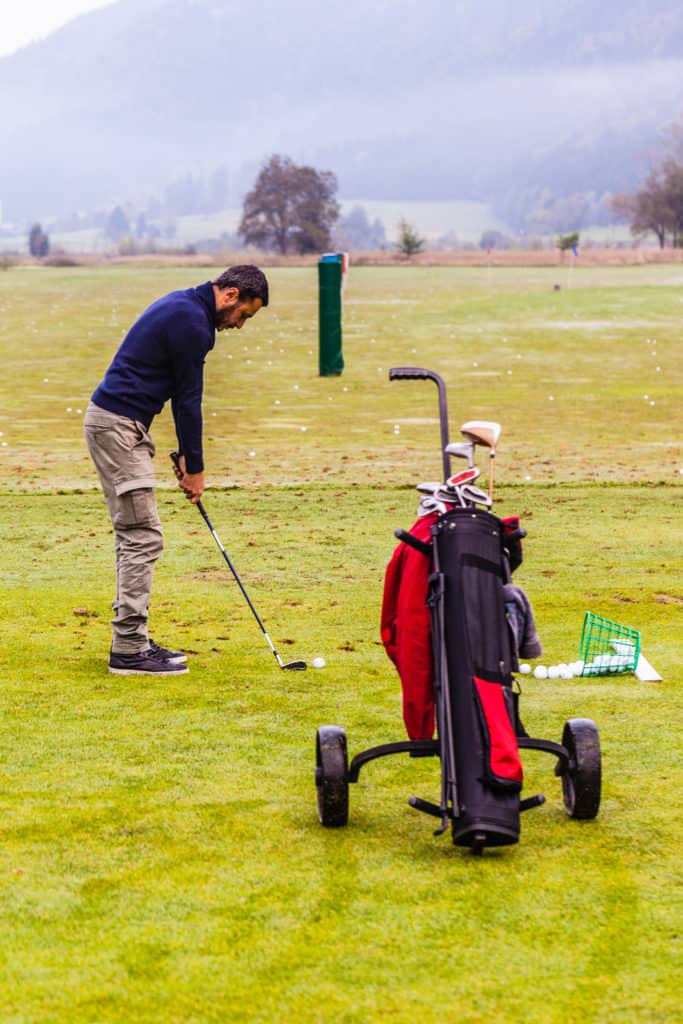Whether you are new to the game or have played for over 30 years, you have probably heard some of the same old advice: keep your head down, make sure your grip is strong, make sure you are aimed straight and on and on and on. Maybe you have perfected these fundamentals, but still struggle?
The same old pieces of advice may have led your game down a path of inconsistency. Below, we provide a comparison between the old fundamentals and the new fundamentals of golf. While both can help and hold a place in the game, we believe the new fundamentals of golf will make more sense and we will provide drills to help you improve in each of the three new fundamentals of golf.
However, we will provide a brief overview of the old fundamentals because having a baseline knowledge does help, but also share some of the variation or inconsistencies on why we think these fundamentals can be problematic. When you are introduced to the new fundamentals, it will just make sense.

We consider the old fundamentals of golf to be the following:
- Alignment
- Grip
- Ball Position
- Posture
Fundamentals of the golf swing – Alignment
Many instructors will tell you that the importance of aiming straight is vital. They will often tell you to imagine railroad tracks and the club should be aimed down one side and your feet down the other, creating a very square alignment. However, you have probably watched Lee Trevino golf on television at some point in your life and he always seems to be aiming left or Fred Couples who also aims to the left. Or on the opposite side with Arnold Palmer and Sam Snead, two of the best to ever play the game, who aim to the right.
So where should you aim? I would recommend experimenting with all three alignments and see what is most comfortable to you. Shane Clement, one of today’s populate online instructors, promotes a diagnosis stance. The main point is that we struggle to call alignment a fundamental because great players of the past and today have great variation in their alignment. Hitting a ball square to square is nearly impossible and golfers used their stance and alignment to work to curve the ball and eliminate one side of the golf course.
The best golfers in the world and even your single digit amateurs are working the ball either right to left or left to right. This can vary based on the shot or shot preference for each individual golfer, but I can guarantee you this, they aren’t aiming straight and trying to hit the ball perfectly straight. The shot trackers used in many of the broadcast for the PGA Tour show you how much players work the ball.
Fundamentals of the golf swing – Grip
There are some basics to the grip that are important. You will want to have the grip across the fingers in your left hand with your hand more on top to control the club face better. As far as if your grip is strong (rotated to the right) or on the weaker side (rotated to the left) can vary depending on other movements in your swing.
Consider that Ben Hogan played with a very weak grip later in his career to prevent the dreaded hook shot, while Sam Snead played with a very strong grip. If you visited a PGA Tour event and sat at the tee box on from the caddie view, you will get a good view of where the grips are on tour and you will see a wide variation. There seems to be a shift towards stronger grips on the PGA Tour, but one can still play at the pro level with a weak grip.

This shows that the grip isn’t necessarily a fundamental because there is no one way to grip a club. Even consider the interlocking grip and the overlapping grip, which are two different ways to connect your hands on your grip.
Fundamentals of the golf swing – Ball Position
Another great variable within the instruction in the golf world. You will find some instructors that want you to play the ball off the left chest on every shot. Jack Nicklaus played golf from a single ball position. Tiger Woods moves the ball around in his stance.
Having listened to many podcasts, taken lessons from PGA instructors and viewed thousands of youtube instructional videos, I can tell you that you will find various takes on where the ball position should be. There have been great golfers that play the ball forward in their stance and great golfers that play the ball back in their stance. The point once again is that the ball position does vary from golfer to golfer and may not be a true fundamental because of the great variation.
Fundamentals of the golf swing – Posture
I am sure you have all seen Adam Scott set up to a golf ball. He has the “textbook” posture that was taught for the past 20-30 years. The back was straight, the butt stuck out a big, with the head lifted up – however take what George Gankas teachers now and you will find a more rounded back with the golfers standing a big straighter with the head more down. This allows certain movements in the swing and for the golfer to be more athletic.
It allows the golfer to engage the ground in the swing and use the ground forces to create additional speed. On tour you will find the Adam Scott setup and golfers like Matt Wolff who are more relaxed with a different type of setup. Check out George Gankas Instagram page to see the opposite of the Adam Scott type of setup. To learn more about George Gankas – Check out our post.

Fundamentals of the golf swing – Old Fundamentals Summary
While it is important to have a consistent posture, grip, alignment – these are all unique to the golfer and the movements made in the swing. You will find great golfers that have a wide variation in all four of the “fundamentals” listed above. The best thing to do is study some of the best golfers of the past and the best golfers of today to see the variation that is out there.
Another great debate in the golf world is whether the head should stay centered or move off of the ball. All of this conflicting information in the game of golf has made it difficult for the amateur to improve and get better. However, when you consider the 3 “new” fundamentals below, your perspective will change and you can use this as your lens.
Looking from some Golf Swing Aids – Check out our Top 5
The New Fundamentals of The Golf Swing:
- Hitting the ground in the same spot every time
- Hitting the ball far enough to play the course
- Controlling the curve of the ball
The best golfers in the world are able to hit the ground in the same spot every time, have enough power to score well on the course and can control their shot patterns through controlling the side spin on the ball. Once I was able to understand these fundamentals and play golf year round, I was able to get better. Check out our articles on golf simulators and playing year round.
The New Fundamentals of Golf – Hitting the Ground in the Same Spot Every Time
When someone first starts to golf they have difficulty hitting the ground in the same spot every time. The variation of where they hit the ball will be greater than the single digit handicap golfer. The newer golfer is trying to hit at the ball and potentially has many swing faults including pulling the arms apart which creates this wide variation. Their landing spot will often be behind the line or the ball with a greater dispersion. The number one way to control the spot where the club hits the ground is to control the weight and where it is in the swing.
Drill 1: This first drill is more of an assessment. Take some simple yard paint and spray a straight line. See how many times you can hit the front side of the line. Go ahead and write that number down.
Drill 2: Put 70 percent of your weight on your left side and do the same drill as above. Once again write down the number of times you can hit the ground on the front side of the line. You should find that by putting 70 percent of the weight forward and keeping it there that you should have more success. Continue to practice this drill and monitor your progress over the coming months. You can start as simple as half swing to help bring some awareness of where your weight is and to ingrain this feeling into your system.
The New Fundamentals of Golf – Hitting the Ball Far Enough To Play the Course
The reality is that you need enough swing speed to be able to play a course. If you simple took your putting stroke all the way around the course, you will hit the ball straight, but wouldn’t have enough distance to score well. There are different ways to increase swing speed that include improving your mechanics or training for speed. The reality is that the further we hit the ball, the easier it is to score lower.
On the PGA Tour is very apparent on the need for speed. Even amateurs need speed. From an analytic standpoint, if you drive the ball 20-30 yards further, you will have less yardage into the green, which will increase your chances of hitting the ball closer, which then makes you a better putter.
Drills: Speed Training
We can all use more speed – Looking to gain more Speed and Distance in your swing? We recommend these Two Excellent Options:
SuperSpeed Golf – Read our Full Review
Gain 30-40 yards in 30 Days – Swing Man Golf

The New Fundamentals of Golf – Controlling the Curve of the Ball
The best golfers are able to control the curve of the ball. Many will be able to eliminate one side of the course by always curving the ball away from trouble or ensuring that they don’t over curve the ball one way or the other. Understanding the new ball flight laws will help you in your journey to play better golf. Consider this: the ball generally start where the club face is pointing at impact and it is fine and acceptable for it to be slight left or right of the target line. It will then curve away from the path.
For example – if you have your club face 2 degrees open or to the right, and your path is 4-5 degrees out to the right, the ball flight will be a slight draw. This will be a push draw, one that starts right and then draws back towards the target. The opposite of this is when the club face is left of the target line, let’s say 2 degrees closed, and the path is 4-5 degrees left or across the ball, the ball will start left and fade back to the right. Many golfers will even start with a slightly open face to help promote the push draw shot that is preferred by many. The best golfers are able to control the club face and the swing path to ultimately control the curve of the ball.
Drill: Practice half swing, with your club face slightly open and then swing out to the right. You will find out how easy it can be to hit a baby push draw. Use this drill often to perfect that baby draw from with a simple swing. In my opinion, the most beautiful shot in golf.
These new fundamentals are covered in great depth in the Stack and Tilt Book. Many people have opinions about the Stack and Tilt Golf Swing, but at the end of the day they make a compelling argument on the new fundamentals of golf and dive into how to get better in each of these three areas. There are many elements that can help many golf swings. They have had a major impact on the PGA Tour. It is worth reading the book, even if you do not want to fully commit to the Stack and Tilt, just gaining a better understanding of ball flight laws and how the swing works, will help you! Check Current Price on Amazon
And Finally…
Golf can be a difficult game, especially with the conflicting information that is out there. Understanding the new fundamentals of golf will hopefully help simplify what we are all trying to accomplish – lower scores and great consistency. We have provided a great deal of information on who we think are the best online instructors – Visit Our Post on our TOP 5.
We have also provided guides on how to break 100, 90, 80 and 70. Check out more below, if interested.
I am an amateur golfer on a journey to get better, enjoy the game as often as possible and share my passion and knowledge with others. I have coached high school golfers at a high level and have a great passion for the game and want to give back. I enjoy learning about the golf swing and am currently studying to be a certified professional golf instructor. Join me in our journey to get better everyday. Thank you for reading!

